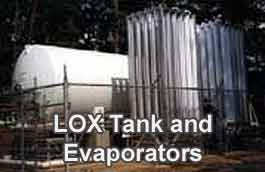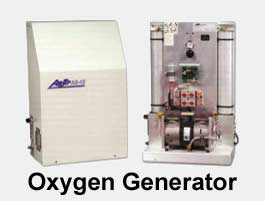 |
 |
Oxygenation adds cost to recirculation production, but the benefit is that system production can be increased 50% or more. The advantage here, of course, is that capital investment in the production system is used more productively. The only way to determine if oxygenation is cost effective is to do a cost/benefit analysis. The question is whether the cost of installation and running of an oxygenation system is offset by the extra fish that can be grown during the service life of the entire system. In other words, the cost per pound of fish of oxygenation is compared to the reduced cost per pound of system depreciation. In one analysis on a moderately large system, oxygenation added about 5% to the cost per pound and was determined to be justified.
|
|
|
There are two sources of pure oxygen for recirculation aquaculture. One is liquid oxygen that can be purchased from industrial sources and the other is oxygen generated from the air using an oxygen generator. Liquid oxygen requires a special tank and evaporators to vaporize the gas. Oxygen generation requires a machine to separate O2 from the air. Both sources have to be distributed to the tanks in special plumbing installed by people certified to work with liquid oxygen distribution because of the fire hazard of leaks. Liquid oxygen has to be purchased, of course, but has the advantage of needing no electricity for use. A regulator meters it as it evaporates generating its own pressure. The oxygen generator requires a relatively large amount of power and is susceptible to power outages. Again, the more cost effective source must be determined in each case, depending on local costs of liquid oxygen and power and the frequency of power outages.
Regardless of its source, pure oxygen is expensive and must be used more efficiently than aeration. The aquaculturist must strive to have 100% of the oxygen transferred to the water. It is not acceptable to simply bubble liquid oxygen into the tank allowing much of it to escape directly to the atmosphere. There are five basic approaches to maximizing transfer of pure oxygen to water.
U-tubes use hydrostatic pressure from a column of water to force oxygen into solution. The column is typically 30 to 150 feet (10 - 50 m). The easiest way to produce this deep water is to use well drilling machinery to produce a hole in the earth and insert two pipes, one inside the other. The outer one is closed at the bottom, but the inner one is not. Water flows down the inner tube and up the outer one. So, the tube is not a "U" in the conventional sense, but functions like one.
Oxygen bubbles are injected as the water enters the downward flowing pipe. As they are carried deep they dissolve at a total pressure of several atmospheres (one additional atmosphere (760 mmHg) for each 30 ft (10m) of hydrostatic pressure. This hydrostatic pressure plus the fact that the gas pressure of oxygen in the bubbles is not shared by any other gases (so it is not "partial" but the combined total of the hydrostatic and atmospheric pressures) results in super saturation of oxygen as it returns to the surface. While supersaturation is possible whenever pure oxygen is used, it always occurs with the U-tube. Fish can tolerate oxygen supersaturation of up to about 150%, but beyond that is too risky, so oxygenated water may need to be diluted before it reaches a fish's gill. A related and much more dangerous condition is nitrogen supersaturation. Nitrogen supersaturation of over 125% results in gas bubble disease that quickly kills fish, so care must be taken to never let bubbles of air enter a U-tube. While a U-tube can result in concentrations of oxygen up to 40 mg/L it is not particularly efficient at transfer, with only about 50%. Off gas recycling as the water returns to the surface can increase this substantially.
These generate a large surface area for diffusion within a pure oxygen atmosphere. A packed column is essentially a small version of a trickle filter. Media is packed into a column to break the water up into a large surface area as it trickles down over it. Oxygen flows upward through the tube to generate a countercurrent transfer. If the column is open at the top, care must be taken to ensure that oxygen is not being lost to the atmosphere. An alternative is to seal the top and recycle the off gas. Of course, the media is soon colonized by bacteria. This is good, up to a point, because it adds nitrification capacity, but it can be a problem if the column clogs. A spray box achieves a large surface area for diffusion by spraying water into an enclosed container of pure oxygen. This may be as simple as a floating paddle aerator in the fish tank sitting under an inverted clear plastic box connected to the oxygen supply.
This device consists of a sealed box subdivided into multiple compartments. Water enters at the top, falls through the compartments, and exits at the bottom. Pure oxygen flows into one side and then from one compartment to another through small holes. As the water spills down through the oxygen, diffusion occurs. The benefit of this system is that the atmosphere in each successive compartment contains less oxygen and more off gases, so by the time the gas mixture exits the last compartment, little oxygen is wasted.
Use of Pure Oxygen Continued in the Next Chapter...